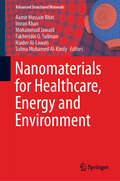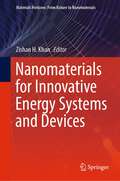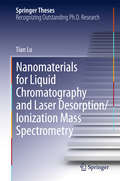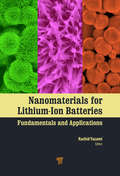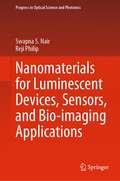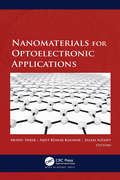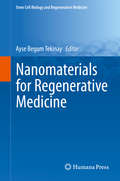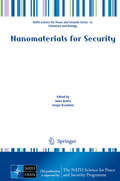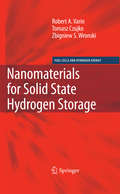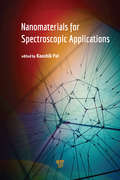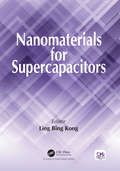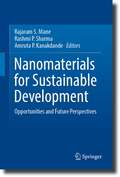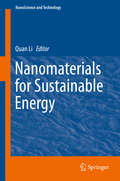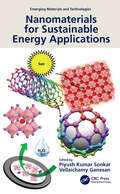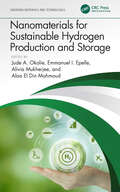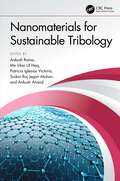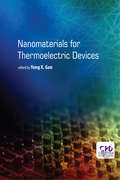- Table View
- List View
Nanomaterials for Fuel Cell Catalysis (Nanostructure Science and Technology)
by Kenneth I. Ozoemena Shaowei ChenGlobal experts provide an authoritative source of information on the use of electrochemical fuel cells, and in particular discuss the use of nanomaterials to enhance the performance of existing energy systems. The book covers the state of the art in the design, preparation, and engineering of nanoscale functional materials as effective catalysts for fuel cell chemistry, highlights recent progress in electrocatalysis at both fuel cell anode and cathode, and details perspectives and challenges in future research.
Nanomaterials for Healthcare, Energy and Environment (Advanced Structured Materials #118)
by Aamir Hussain Bhat Imran Khan Mohammad Jawaid Fakhreldin O. Suliman Haider Al-Lawati Salma Muhamed Al-KindyThis book highlights the various types of nanomaterials currently available and their applications in three major sectors: energy, health, and the environment. It addresses a range of aspects based on the fact that these materials’ structure can be tailored at extremely small scales to achieve specific properties, thus greatly expanding the materials science toolkit. Further, the book pursues a holistic approach to nanomaterial applications by taking into consideration the various stakeholders who use them. It explores several applications that could potentially be used to improve the environment and to more efficiently and cost-effectively produce energy, e.g. by reducing pollutant production during the manufacture of materials, producing solar cells that generate electricity at a competitive cost, cleaning up organic chemicals that pollute groundwater, removing volatile organic compounds (VOCs) from the air, and so on. Given its scope, the book offers a valuable asset for a broad readership, including professionals, students, and researchers from materials science/engineering, polymer science, composite technology, nanotechnology, and biotechnology whose work involves nanomaterials and nanocomposites.
Nanomaterials for Innovative Energy Systems and Devices (Materials Horizons: From Nature to Nanomaterials)
by Zishan H. KhanThis book covers the latest research on applications of nanomaterials in the field of energy systems and devices. It provides an overview of the state-of-art research in this rapidly developing field. It discusses the design and fabrication of nanostructured materials and their energy applications. Various topics covered include nanomaterials for perovskite solar cells, transition metal dichalcogenides (TMDs) nanocomposites based supercapacitors, battery materials and technologies, major challenges toward development of efficient thermoelectric materials for energy efficient devices, extraction and experimentation of biodiesel produced from leachate oils of landfills coupled with nano-additives aluminium oxide and copper oxide on diesel engine and many more. It has contributions from world-renowned specialists in the fields of nanomaterials and energy devices. The book will be useful for students, researchers and professionals working in the area of nanomaterials and energy systems & devices.
Nanomaterials for Liquid Chromatography and Laser Desorption/Ionization Mass Spectrometry (Springer Theses)
by Tian LuTian Lu's dissertation describes major advances in ultrathin-layer chromatography (UTLC), liquid chromatography and surface-assisted laser desorption ionization (SALDI), and matrix-enhanced SALDI (ME-SALDI) mass spectrometry. Lu describes the fabrication of electrospun polyvinyl alcohol (PVA) UTLC plates using an in-situ crosslinking electrospinning technique. The author improved the efficiency of PVA plates greatly compared to the efficiency of silica HPTLC plates. Also highlighted in this thesis is an edge-plane based ordered-carbon surface that provides unique selectivity in liquid chromatography. Further developments include polar analytes, such as amino acids, nucleotides and nucleosides which can be well-retained and separated in the edge-plane ordered-carbon stationary phase. Also, the author studied and detected mass spectra of organic polymers as high as 900,000 Da, the highest molecular weight that has been studied by SALDI to date using the carbon nanofibrous substrate. This thesis has led to a number of publications in high-impact journals.
Nanomaterials for Lithium-Ion Batteries: Fundamentals and Applications
by Rachid YazamiThis book covers the most recent advances in the science and technology of nanostructured materials for lithium-ion application. With contributions from renowned scientists and technologists, the chapters discuss state-of-the-art research on nanostructured anode and cathode materials, some already used in commercial batteries and others still in de
Nanomaterials for Luminescent Devices, Sensors, and Bio-imaging Applications (Progress in Optical Science and Photonics #16)
by Swapna S. Nair Reji PhilipThis book highlights the synthesis/fabrication of novel materials for different kinds of optical applications. It covers all aspects of optical applications starting from LED/Lasers, SERS, bio-sensing, bio-imaging and non-linear optical applications such as optical limiting, saturable absorbers etc. The book describes the development of novel materials and geometry as well as engineering of their size and shape for harvesting better optical properties. Nonconventional plasmonic materials and their fabrication are discussed apart from the conventionally employed noble metal based nanosystems. In addition, development of Novel materials/structures for biosensing /bioimaging /optical limiting are also covered.
Nanomaterials for Optoelectronic Applications
by Mohd. Shkir; Ajeet Kumar Kaushik; Salem AlFaifyThis book shines a spotlight on the significance and usefulness of nanomaterials for the development of optoelectronic devices and their real-life applications. It presents an informative overview of the role of nanoscale materials in the development of advanced optoelectronic devices at nanoscale and discusses the applications of nanomaterials in different forms prepared by diverse techniques in the field of optoelectronic and biomedical devices. Major features, such as type of nanomaterials, fabrication methods, applications, tasks, benefits and restrictions, and saleable features, are well covered. Key features: • Explains the features of 0D, 1D, 2D and 3D nanomaterials • Exhibits the wide range of applications of nanomaterials in optoelectronics, photonics, biosensing, x-rays and x-ray detectors, medical imaging, visible light photodetectors, etc. • Discusses the advances in miniaturized nanoscale devices for biomedical applications • Describes the various preparation methods for advanced nanomaterials and their functionalization for fabrication of nanoelectronics devices
Nanomaterials for Optoelectronic Applications
by Mohd. Shkir Ajeet Kumar Kaushik Salem AlFaifyThis book shines a spotlight on the significance and usefulness of nanomaterials for the development of optoelectronic devices and their real-life applications. It presents an informative overview of the role of nanoscale materials in the development of advanced optoelectronic devices at nanoscale and discusses the applications of nanomaterials in different forms prepared by diverse techniques in the field of optoelectronic and biomedical devices. Major features, such as type of nanomaterials, fabrication methods, applications, tasks, benefits and restrictions, and saleable features, are well covered. Key features: • Explains the features of 0D, 1D, 2D and 3D nanomaterials • Exhibits the wide range of applications of nanomaterials in optoelectronics, photonics, biosensing, x-rays and x-ray detectors, medical imaging, visible light photodetectors, etc. • Discusses the advances in miniaturized nanoscale devices for biomedical applications • Describes the various preparation methods for advanced nanomaterials and their functionalization for fabrication of nanoelectronics devices
Nanomaterials for Regenerative Medicine (Stem Cell Biology and Regenerative Medicine)
by Ayse Begum TekinayThis book covers a broad range of therapeutic applications of nanomaterials that are used for regenerative medicine applications, including neural regeneration, cartilage regeneration, wound healing, dental regeneration and implants, and immunomodulation. Chapters are contributed by leading experts in the field and cover concepts for developing materials for medicine as well as requirements for potential clinical uses. Nanomaterials for Regenerative Medicine also provides the requirements for the design of optimal nanomaterials for regenerative medicine and covers the most recent approaches in nanomaterial design. It is ideal for graduate students and researchers in chemistry, biology, materials science, medicine, and life sciences.
Nanomaterials for Security (NATO Science for Peace and Security Series A: Chemistry and Biology)
by Janez Bonča Sergei KruchininThis book comprises 25 contributions focussed on nanotechnology for sensor applications. They stem from presentations at the NATO Advanced Research Workshop "Nanomaterials for Security". The chapters cover a broad but interrelated range of topics, including nanophysics, nanotechnology, nanomaterials, sensors, biosensor security systems, and explosive detection. They reflect many significant advances over the past two years as well as some entirely new directions of research that are just beginning to be explored.
Nanomaterials for Solid State Hydrogen Storage (Fuel Cells and Hydrogen Energy)
by Zbigniew S. Wronski Tomasz Czujko Robert A. VarinOver the past decade, important advances have been made in the development of nanostructured materials for solid state hydrogen storage used to supply hydrogen to fuel cells in a clean, inexpensive, safe and efficient manner. Nanomaterials for Solid State Hydrogen Storage focuses on hydrogen storage materials having high volumetric and gravimetric hydrogen capacities, and thus having the highest potential of being applied in the automotive sector. Written by leading experts in the field, Nanomaterials for Solid State Hydrogen Storage provides a thorough history of hydrides and nanomaterials, followed by a discussion of existing fabrication methods. The authors’ own research results in the behavior of various hydrogen storage materials are also presented. Covering fundamentals, extensive research results and recent advances in nanomaterials for solid state hydrogen storage, this book serves as a comprehensive reference.
Nanomaterials for Spectroscopic Applications
by Kaushik PalThis book provides an overview of key current developments in the synthetic strategy of functional novel nanomaterials in various spectroscopic characterizations and evaluations and highlights possible future applications in nanotechnology and materials science. It illustrates the wide-ranging interest in these areas and provides a background to the later chapters, which address the novel synthesis of high-yield nanomaterials and their biomaterials, graphene, polymeric nanomaterials, green nanomaterials, green polyester, liquid crystal electro-optic switching applications, nanobiotechnology, transition metal oxides, response characteristics of exclusive spectroscopic investigation as well as electron microscopic study, flexible and transparent electrodes, optoelectronics, nanoelectronics, smart displays, switchable device modulation, health care, energy storage, solar/fuel cells, environmental and plant biology, social, ethical, and regulatory implications of various aspects of green nanotechnology, as well as significant foreseeable spectroscopic applications of key functional nanomaterials. Given appropriate regulation for and research on the topics covered, commercial production of manufactured novel composite materials can be realized. Furthermore, the many discoveries highlighted in the book can modulate spectroscopic performances with technical excellence in multidisciplinary research of high competence.
Nanomaterials for Spectroscopic Applications
by Kaushik PalThis book provides an overview of key current developments in the synthetic strategy of functional novel nanomaterials in various spectroscopic characterizations and evaluations and highlights possible future applications in nanotechnology and materials science. It illustrates the wide-ranging interest in these areas and provides a background to the later chapters, which address the novel synthesis of high-yield nanomaterials and their biomaterials, graphene, polymeric nanomaterials, green nanomaterials, green polyester, liquid crystal electro-optic switching applications, nanobiotechnology, transition metal oxides, response characteristics of exclusive spectroscopic investigation as well as electron microscopic study, flexible and transparent electrodes, optoelectronics, nanoelectronics, smart displays, switchable device modulation, health care, energy storage, solar/fuel cells, environmental and plant biology, social, ethical, and regulatory implications of various aspects of green nanotechnology, as well as significant foreseeable spectroscopic applications of key functional nanomaterials. Given appropriate regulation for and research on the topics covered, commercial production of manufactured novel composite materials can be realized. Furthermore, the many discoveries highlighted in the book can modulate spectroscopic performances with technical excellence in multidisciplinary research of high competence.
Nanomaterials for Supercapacitors
by Ling Bing KongNew materials hold the key to fundamental advances in energy conversion and storage, both of which are vital in order to meet the challenge of global warming and the finite nature of fossil fuels. Nanomaterials in particular offer unique properties or combinations of properties as electrodes and electrolytes in a range of energy devices. Supercapacitors have been widely acknowledged to be promising devices for energy storage. This book describes the latest progress in the discovery and development of nanoelectrolytes and nanoelectrodes for supercapacitor applications.
Nanomaterials for Supercapacitors
by Ling Bing KongNew materials hold the key to fundamental advances in energy conversion and storage, both of which are vital in order to meet the challenge of global warming and the finite nature of fossil fuels. Nanomaterials in particular offer unique properties or combinations of properties as electrodes and electrolytes in a range of energy devices. Supercapacitors have been widely acknowledged to be promising devices for energy storage. This book describes the latest progress in the discovery and development of nanoelectrolytes and nanoelectrodes for supercapacitor applications.
Nanomaterials for Sustainable Development: Opportunities and Future Perspectives
by Rajaram S. Mane Rashmi P. Sharma Amruta P. KanakdandeThis book highlights recent advances in variety of nanomaterials classes including metal chalcogenides, metal oxides/hydroxides, polymer, metal-organic frameworks, and hybrid nanostructures, with a focus on their properties, synthesis methods, and key applications. It also offers detailed coverage on the toxicity aspects with possible solution. Additionally, it provides complete and comprehensive information on surface modification strategies of nanoparticles to achieve desired outcomes. This book discusses potential applications and major challenges of using these nanomaterials in the fields of biomedical sciences, agricultural industry, bioenergy, biofuel production, and environmental remediation, etc. Overall, this book provides crucial background in nanobiotechnology that compliments the understanding of experimental design for the production of more customized nanomaterials to avail desirable benefits.
Nanomaterials for Sustainable Energy (NanoScience and Technology)
by Quan LiThis book presents the unique mechanical, electrical, and optical properties of nanomaterials, which play an important role in the recent advances of energy-related applications. Different nanomaterials have been employed in energy saving, generation, harvest, conversion, storage, and transport processes very effectively and efficiently. Recent progress in the preparation, characterization and usage of 1D, 2D nanomaterials and hybrid architectures for energy-related applications and relevant technologies and devices, such as solar cells, thermoelectronics, piezoelectronics, solar water splitting, hydrogen production/storage, fuel cells, batteries, and supercapacitors is covered. Moreover, the book also highlights novel approaches in nanomaterials design and synthesis and evaluating materials sustainability issues. Contributions from active and leading experts regarding important aspects like the synthesis, assembly, and properties of nanomaterials for energy-related applications are compiled into a reference book. As evident from the diverse topics, the book will be very valuable to researchers working in the intersection of physics, chemistry, biology, materials science and engineering. It may set the standard and stimulates future developments in this rapidly emerging fertile frontier of nanomaterials for energy.
Nanomaterials for Sustainable Energy Applications (Emerging Materials and Technologies)
by Piyush Kumar Sonkar Vellaichamy GanesanThis book provides a detailed overview of different devices and nanomaterials for energy storage applications. The application of each nanomaterial is discussed for fuel cells, metal–air batteries, supercapacitors, solar cells, regenerative fuel cells, hydrogen energy, batteries, and redox flow batteries to understand the reaction process and material performance improvement for energy storage devices. In addition, major challenges, case studies, historical, and future perspective are summarized. Features: Summarizes state-of-the-art nanomaterials for energy storage and conversion applications Comprehensive coverage of a wide range of nanomaterials, including synthesis and characterization Details different energy storage devices, construction, working principles, and major challenges Covers specific reactions, nanomaterials, and nanocomposites via audio–video slides/short films Includes case studies pertaining to development of energy storage devices and major challenges This book is aimed at researchers and graduate students in chemical engineering, chemical sciences, nanomaterials, and energy engineering/conversion.
Nanomaterials for Sustainable Energy Applications (Emerging Materials and Technologies)
This book provides a detailed overview of different devices and nanomaterials for energy storage applications. The application of each nanomaterial is discussed for fuel cells, metal–air batteries, supercapacitors, solar cells, regenerative fuel cells, hydrogen energy, batteries, and redox flow batteries to understand the reaction process and material performance improvement for energy storage devices. In addition, major challenges, case studies, historical, and future perspective are summarized. Features: Summarizes state-of-the-art nanomaterials for energy storage and conversion applications Comprehensive coverage of a wide range of nanomaterials, including synthesis and characterization Details different energy storage devices, construction, working principles, and major challenges Covers specific reactions, nanomaterials, and nanocomposites via audio–video slides/short films Includes case studies pertaining to development of energy storage devices and major challenges This book is aimed at researchers and graduate students in chemical engineering, chemical sciences, nanomaterials, and energy engineering/conversion.
Nanomaterials for Sustainable Hydrogen Production and Storage (Emerging Materials and Technologies)
by Jude A. Okolie Emmanuel I. Epelle Alivia Mukherjee Alaa El Din MahmoudHydrogen is poised to play a major role in the transition towards a net-zero economy. However, the worldwide implementation of hydrogen energy is restricted by several challenges, including those related to practical, easy, safe, and cost-effective storage and production methodologies. Nanomaterials present a promising solution, playing an integral role in overcoming the limitations of hydrogen production and storage. This book explores these innovations, covering a wide spectrum of applications of nanomaterials for sustainable hydrogen production and storage. Provides an overview of the hydrogen economy and its role in the transition to a net-zero economy. Details various nanomaterials for hydrogen production and storage as well as modeling and optimization of nanomaterials production. Features real-life case studies on innovations in nanomaterials applications for hydrogen storage. Discusses both the current status and future prospects. Aimed at researchers and professionals in chemical, materials, energy, environmental and related engineering disciplines, this work provides readers with an overview of the latest techniques and materials for the development and advancement of hydrogen energy technologies.
Nanomaterials for Sustainable Hydrogen Production and Storage (Emerging Materials and Technologies)
Hydrogen is poised to play a major role in the transition towards a net-zero economy. However, the worldwide implementation of hydrogen energy is restricted by several challenges, including those related to practical, easy, safe, and cost-effective storage and production methodologies. Nanomaterials present a promising solution, playing an integral role in overcoming the limitations of hydrogen production and storage. This book explores these innovations, covering a wide spectrum of applications of nanomaterials for sustainable hydrogen production and storage. Provides an overview of the hydrogen economy and its role in the transition to a net-zero economy. Details various nanomaterials for hydrogen production and storage as well as modeling and optimization of nanomaterials production. Features real-life case studies on innovations in nanomaterials applications for hydrogen storage. Discusses both the current status and future prospects. Aimed at researchers and professionals in chemical, materials, energy, environmental and related engineering disciplines, this work provides readers with an overview of the latest techniques and materials for the development and advancement of hydrogen energy technologies.
Nanomaterials for Sustainable Tribology
by Ankush Raina Mir Irfan Ul Haq Patricia Iglesias Victoria Sudan Raj Jegan Mohan Ankush AnandWith the advent of nanotechnology, the properties offered by nano-sized particles in various engineering applications have revolutionized the area of material science. Furthermore, due to the use of nanomaterials in various engineering components, particularly in moving parts, it is imperative to understand the behavior of these nanomaterials under sliding conditions. Therefore, an augmented approach of nanotechnology and tribology has been addressed in this book. It presents recent advancements on the topics related to Mechanical and tribological behaviour of nanocomposites Nanomaterials in lubricating oils Synergetic effects of nanomaterials Surface texturing at nano-scale Nanocoatings for various applications Biotribological applications of nanomaterials Nanomaterials for Sustainable Tribology covers major aspects of tribology of nanomaterials, and its current status and future directions. This book will provide the readers an insight on several aspects of tribology of nanomaterials. It will act as a strong stimulant for readers to appreciate and initiate further advancements in the field of tribology, particularly at nano-scale.
Nanomaterials for Sustainable Tribology
by Ankush Raina Mir Irfan Ul Haq Patricia Iglesias Victoria Sudan Raj Jegan Mohan Ankush AnandWith the advent of nanotechnology, the properties offered by nano-sized particles in various engineering applications have revolutionized the area of material science. Furthermore, due to the use of nanomaterials in various engineering components, particularly in moving parts, it is imperative to understand the behavior of these nanomaterials under sliding conditions. Therefore, an augmented approach of nanotechnology and tribology has been addressed in this book. It presents recent advancements on the topics related to Mechanical and tribological behaviour of nanocomposites Nanomaterials in lubricating oils Synergetic effects of nanomaterials Surface texturing at nano-scale Nanocoatings for various applications Biotribological applications of nanomaterials Nanomaterials for Sustainable Tribology covers major aspects of tribology of nanomaterials, and its current status and future directions. This book will provide the readers an insight on several aspects of tribology of nanomaterials. It will act as a strong stimulant for readers to appreciate and initiate further advancements in the field of tribology, particularly at nano-scale.
Nanomaterials for Thermoelectric Devices
by Yong X. GanWith the increaseing global demand for energy, we are facing a huge challenge of energy sustainability. Renewable energy has attracted an immense amount of interest with regard to solving the sustainbility issue. Among the various renewable energy sources, solar heat and waste heat energy has significant advantages due to its availability. Thermoelectric nanomaterials play an indispensable role in heat-to-electricity energy conversion. A high energy conversion efficiency is critical for practical applications of thermoelectric energy conversion systems, and understanding the fundamentals of energy conversion mechanisms is essential. This book details thermoelectric energy conversion nanomaterials and the related manufacturing processes. It also introduces the latest research progress in thermoelectric energy conversion nanomaterials. It is a great reference for readers from both academia and industry.
Nanomaterials for Thermoelectric Devices
by Yong X. GanWith the increaseing global demand for energy, we are facing a huge challenge of energy sustainability. Renewable energy has attracted an immense amount of interest with regard to solving the sustainbility issue. Among the various renewable energy sources, solar heat and waste heat energy has significant advantages due to its availability. Thermoelectric nanomaterials play an indispensable role in heat-to-electricity energy conversion. A high energy conversion efficiency is critical for practical applications of thermoelectric energy conversion systems, and understanding the fundamentals of energy conversion mechanisms is essential. This book details thermoelectric energy conversion nanomaterials and the related manufacturing processes. It also introduces the latest research progress in thermoelectric energy conversion nanomaterials. It is a great reference for readers from both academia and industry.
